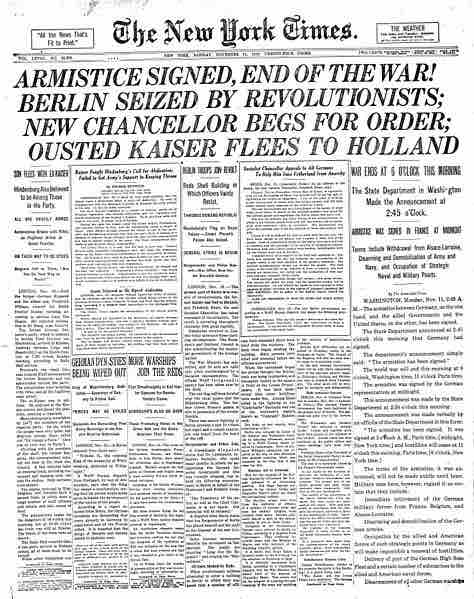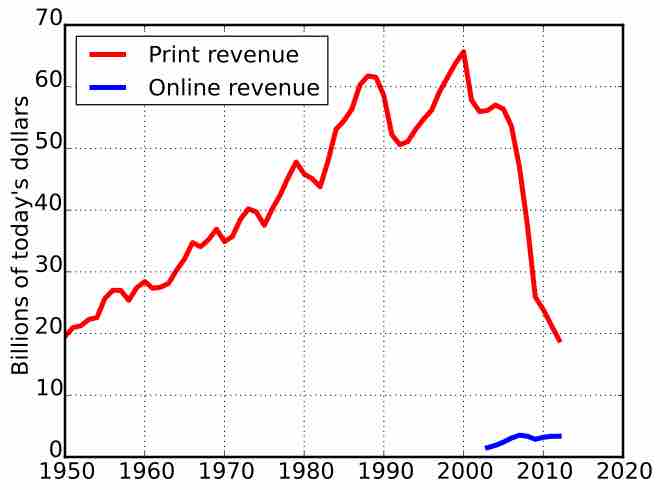Newspaper
The main form of print media is the newspaper. A newspaper is a scheduled publication containing news of current events, informative articles, diverse features, editorials, and advertising . It usually is printed on relatively inexpensive, low-grade paper such as newsprint. By 2007, there were 6,580 daily newspapers in the world selling 395 million copies a day. The worldwide recession of 2008, combined with the rapid growth of web-based alternatives, caused a serious decline in advertising and circulation, as many papers closed or sharply reduced operations.

The New York Times
The front page of the New York Times on Armistice Day, November 11, 1918.
General-interest newspapers typically publish stories on local and national political events and personalities, crime, business, entertainment, society and sports. Most traditional papers also feature an editorial page containing editorials written by an editor and columns that express the personal opinions of writers. The newspaper is typically funded by paid subscriptions and advertising.
The emergence of this new media branch in the 17th century has to be seen in close connection with the spread of the printing press from which the publishing press derives its name. The German-language Relation aller Fürnemmen und gedenckwürdigen Historien, printed from 1605 on wards by Johann Carolus in Strasbourg, is often recognized as the first newspaper.
By the early 19th century, many cities in Europe, as well as North and South America, published newspaper-type publications though content was vastly shaped by regional and cultural preferences. Advances in printing technology related to the Industrial Revolution enabled newspapers to become an even more widely circulated means of communication. In 1814, The Times (London) acquired a printing press capable of making 1,100 impressions per minute.
Soon, the printing press was adapted to print on both sides of a page at once. This innovation made newspapers cheaper and thus available to a larger part of the population. In 1830, the first penny press newspaper came to the market: Lynde M. Walter's Boston Transcript. Penny press papers cost about one sixth the price of other newspapers and appealed to a wider audience. In France, Émile de Girardin started "La Presse" in 1836, introducing cheap, advertising-supported dailies to France.
In the early days of the newspaper business newspapers were often owned by press barons, and were used for gaining a political voice. After 1920 most major newspapers became parts of chains run by large media corporations such as Gannett, The McClatchy Company, Hearst Corporation, Cox Enterprises, Landmark Media Enterprises LLC, Morris Communications, The Tribune Company, Hollinger International, News Corporation, and Swift Communications.
However, newspapers have played an important role in the exercise of freedom of expression. Whistle-blowers and those who "leak" stories of corruption in political circles often choose to inform newspapers before other mediums of communication, relying on the reputation of newspaper editors to expose the secrets and lies that relate to the public. However, there have been many circumstances of the political autonomy of newspapers being curtailed. Recent research has examined the effects of a newspaper's closing on the reelection of incumbents, voter turnout, and campaign spending.
By the late 1990s, the availability of news via 24-hour television channels and then the Internet posed an ongoing challenge to the business model of most newspapers in developed countries. Paid circulation has declined, while advertising revenue — which makes up the bulk of most newspapers' income — has been shifting from print to the new media, resulting in a general decline of profits. Many newspapers around the world launched online editions in an attempt to follow or stay ahead of their audience.
The future of newspapers in countries with easy access to the Internet has been widely debated as the industry has faced soaring newsprint prices, slumping ad sales, the loss of much classified advertising, and precipitous drops in circulation. In recent years the number of newspapers slated for closure, bankruptcy or severe cutbacks has risen—especially in the United States, where the industry has shed a fifth of its journalists since 2001. Revenue has plunged while competition from media on the Internet has threatened older print publishers .

U.S. Newspaper Advertising Revenue
This graph depicts the fall of print advertising revenue and the rise of online advertising revenue.
The debate has become more urgent lately, as a deepening recession has shaved profits, and as once-explosive growth in newspaper web revenues has leveled off, forestalling what the industry hoped would become an important source of its revenue. At issue is whether the newspaper industry faces a cyclical trough, or whether new technology has rendered newspapers obsolete in their traditional format.
However, in the rest of the world, cheaper printing and distribution, increased literacy, the growing middle class and other factors have more than compensated for the emergence of electronic media by allowing newspapers in those regions to continue to grow.
Major American newspapers include: New York Times, Los Angeles Times, USA Today, The Wall Street Journal, and Washington Post. Major American news magazines include: Newsweek, TIME, and U.S. News & World Report.